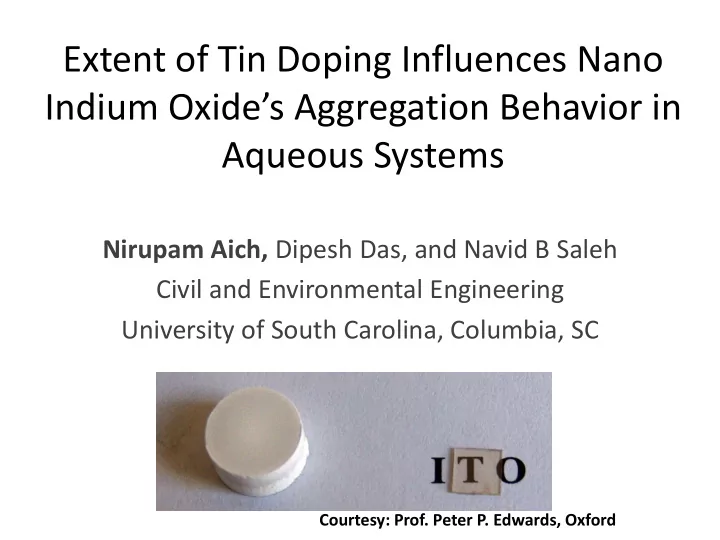

Extent of Tin Doping Influences Nano Indium Oxide’s Aggregation Behavior in Aqueous Systems Nirupam Aich, Dipesh Das, and Navid B Saleh Civil and Environmental Engineering University of South Carolina, Columbia, SC Courtesy: Prof. Peter P. Edwards, Oxford
Outline • Metallic Nanomaterials • Bimetals (Indium Tin Oxide) • Environmental Relevance • Objectives • Experimental Overview • Preliminary Results
Metallic Nanoparticles • Noble metals - Ag, Au, Pt, Pd, Ru, Rh, etc. • Lanthanides - La, Sc, Gd, etc Singular • Quantum dots (CdSe, CdTe, etc) • Metal oxide NPs (ZnO, TiO 2 , SiO 2 , Fe 3 O 4 , CuO, In 2 O 3 , SnO 2 ,etc) • ligand-based metallic compounds (ferrocene) Coated-metals Doped Metals Multiple
Usage Takuya Tsuzuki, International Journal of Nanotechnology, 6 (2009) 567
Environmental Implications and NM Properties Shape Aggregation Size Deposition Crystallinity Transformation Surface chemistry Toxicity Electronic Bandgap
Inspirational Work Bandgap Energy and Cellular Toxicity Potential In 2 O 3 SnO 2 Nel et al. 2012, ACS Nano Toxicity mechanism ROS generation Oxidative damage -4.12 to -4.84 eV Bandgap can be used as a predictive tool for measuring toxic potential of metal oxides
Indium Tin Oxide (ITO) • Solid solution of In 2 O 3 and SnO 2 • Typically 10% tin oxide is doped in Indium oxide • Two major properties – High electrical conductivity – Excellent transparent properties
ITO Applications • More than 95% liquid crystal display
ITO Applications • More than 95% liquid crystal display • Electronic inks •
ITO Applications • More than 95% liquid crystal display • electronic inks • Solar cells and photovoltaics
ITO Applications • More than 95% liquid crystal display • electronic inks • Solar cells and photovoltaics • electromagnetic shielding devices
ITO Applications • More than 95% liquid crystal display • electronic inks • Solar cells and photovoltaics • electromagnetic shielding devices, • Gas sensors http://npol.postech.ac.kr/Research/Nanostructure.htm
ITO Applications • More than 95% liquid crystal display • electronic inks • Solar cells and photovoltaics • electromagnetic shielding devices, • gas sensors, • Photocatalysts for environmental remediation Yumoto, H.; Inoue, T.; Li, S. J.; Sako, T.; Nishiyama, K., Application of ITO films to photocatalysis. Thin Solid Films 1999, 345, (1), 38-41.
Indium Tin Oxide (ITO) Bandgap – Probable Toxicity • Change in crystalline structure due to Tin doping • Defects are introduced • Band gap change occurs • E c of Indium oxide -3.63 eV • E c of ITO -4.10 eV • Chances of overlap of E c with the cellular toxic potential is increased Margalith et al, Indium tin oxide contacts to gallium nitride optoelectronic devices. Applied Physics Letters 1999, 74 , (26), 3930-3932
Biological Effects of ITO • Toxicity of macroscale ITO - Reports of human fatality – Inhalation of particulate ITO – Pneumothorax and Pulmonary fibriosis – Chronic pulmonary and carcinogenic effects • Nano-scale ITO also demonstrates fetal malformations and eco-toxicity • ROS generation is evidenced – but mechanism is not known 1. Homma et al 2005. Pulmonary fibrosis in an individual occupationally exposed to inhaled indium-tin oxide . Eur. Resp. J. 2. Tanaka et al 2012, Pulmonary Toxicity of Indium Tin Oxide and Copper Indium Gallium Diselenide. In Materials Research Society San Francisco, CA, 2012; Vol. 1469, p 12 3. Tanaka et al 2010 Review of pulmonary toxicity of indium compounds to animals and humans. Thin Solid Films. 4. Cummings et al 2012, Indium Lung Disease. Chest 141 , (6), 1512-1521. 5. Hamaguchi et al 2008, Exposure to hardly soluble indium compounds in ITO production and recycling plants is a new risk for interstitial lung damage. Occup. Environ. Med. 65 , (1), 51-55. 6. Lison et al 2010, Pulmonary Alveolar Proteinosis in Workers at an Indium Processing Facility. American Journal of Respiratory and Critical Care Medicine, 182 , (4), 578-578.
Objective • To determine and compare the aggregation kinetics of nanoscale tin-doped and undoped indium oxide under relevant environmental conditions. Hypothesis • Nano-Indium oxide (In 2 O 3 ) when doped with tin (Sn) will demonstrate altered aggregation behavior
Methods and Variables • Sonication filtration • NaCl was used as background electrolyte • Transmission electron microscopy (TEM) for morphology • X-ray diffraction spectrometer (XRD) for crystallinity of ITO • Electron dispersive spectroscopy (X-ray) for composition • Zeta potential measurements for surface charge • Time resolved dynamic light scattering (TRDLS) was used for measuring aggregation
HRTEM nITO nIO
XRD ITO EDX (a) Intensity (a.u.) 10 20 30 40 50 60 70 80 90 100 2 • No signature peaks for tin Indium (at 3.3 keV) - 88.1% • Tin is incorporated substitutionally Tin (at 3.5 keV) - 8.8% into indium oxide lattice. Oxygen (at 0.5 keV) - 3.0±0.5% • 30.54°, 35.4°, 59.98°, and 60.8°; which represent dominance of (222), (400), (440), and (110) lattice planes for IO
Aggregation Kinetics 1 Attachment Efficiency, CCC nITO 180 mM NaCl nITO 0.1 nIO 280 mM NaCl nIO -2 -1 10 10 NaCl Concentration, M Both nIO and nITO are highly stable in aqueous suspension nIO is relatively more stable than nITO Preliminary size 65-70 nm Aggregated size 120-140 nm
Zeta Potential -50 nITO nIO -40 potential, mV -30 -20 -10 0 0.05 0.01 0.03 NaCl Concentration, M
Summary • Nanoscale ITO are environmentally relevant and will likely pose significant environmental risk • Both doped and undoped indium oxide showed enhanced aqueous stability • Tin doping reduces stability of the indium oxide • Likely cause may reside on the van der Waals interaction • Systematic studies are necessary to better understand fate, transport, transformation, and toxicity
ACKNOWLEDGEMENT Dr. Navid Saleh SPARC Graduate Research Fellowship Office of the Vice President for Research University of South Carolina Jaime Plazas-Tutle Dr Tom Vogt, University of South Carolina Dr Eirin Sullivan, Illinoi State University Dr. Haijun Qian, Clemson University Nabiul Afrooz Dipesh Das
Recommend
More recommend